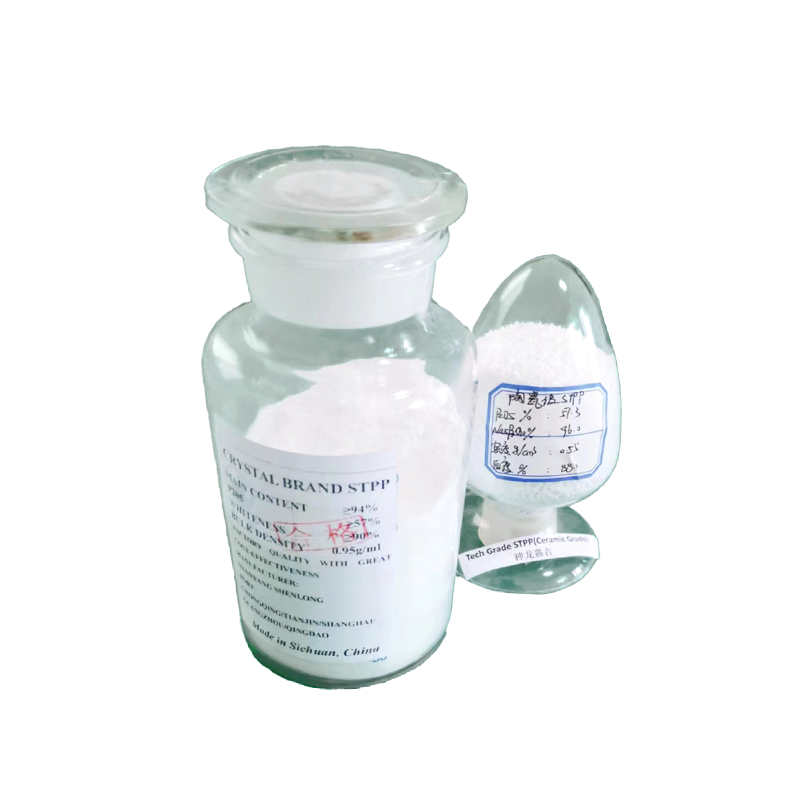Understanding the Factors Influencing Ceramic STPP Prices in the Biochemical Industry
2025-05-30
Ceramic sodium tripolyphosphate (STPP) is a versatile compound widely used in various applications, including detergents, food processing, and ceramics. Understanding the factors that influence the price of ceramic STPP is crucial for manufacturers, suppliers, and end-users in the biochemical industry.
One of the primary factors affecting ceramic STPP prices is the raw material cost. STPP is synth

Ceramic sodium tripolyphosphate (STPP) is a versatile compound widely used in various applications, including detergents, food processing, and ceramics. Understanding the factors that influence the price of ceramic STPP is crucial for manufacturers, suppliers, and end-users in the biochemical industry.
One of the primary factors affecting ceramic STPP prices is the raw material cost. STPP is synthesized from phosphoric acid and soda ash, and fluctuations in the prices of these raw materials can directly impact the final product's pricing. For instance, if the cost of phosphoric acid rises due to supply chain disruptions or increased demand, manufacturers may pass these costs onto consumers, leading to higher ceramic STPP prices.
Another significant factor is the production capacity and technology used in the manufacturing process. Companies that invest in more efficient production technologies may be able to produce ceramic STPP at a lower cost, potentially leading to competitive pricing. In contrast, older manufacturing plants might face higher operational costs, pushing their prices upward. Moreover, production capacities can be affected by regulatory changes or environmental compliance requirements, which may also lead to price fluctuations.
Market demand plays a pivotal role in determining ceramic STPP prices. As global markets evolve, the demand for STPP in various applications, such as ceramics, textiles, or as a food additive, can vary significantly. For example, a surge in demand from the detergent industry, driven by an increase in consumer spending on cleaning products, can elevate prices due to higher competition among manufacturers.
Geopolitical factors can also influence ceramic STPP pricing. Trade policies, tariffs, and international relations can create uncertainty in supply chains, affecting the availability and cost of materials needed for STPP production. Additionally, environmental regulations aimed at reducing the carbon footprint of chemical manufacturing can lead to increased operational costs, further impacting prices.
Lastly, the overall economic environment, including inflation rates and currency fluctuations, can affect both the cost of production and market prices. When inflation rises, it typically leads to increased costs across the board, including labor, materials, and transportation. These increased costs may eventually be reflected in the pricing of ceramic STPP.
In conclusion, the price of ceramic STPP is influenced by a multitude of factors, including raw material costs, production capacity, market demand, geopolitical conditions, and the overall economic landscape. Understanding these elements can aid stakeholders in the biochemical industry in making informed decisions regarding the use and procurement of ceramic STPP.
One of the primary factors affecting ceramic STPP prices is the raw material cost. STPP is synthesized from phosphoric acid and soda ash, and fluctuations in the prices of these raw materials can directly impact the final product's pricing. For instance, if the cost of phosphoric acid rises due to supply chain disruptions or increased demand, manufacturers may pass these costs onto consumers, leading to higher ceramic STPP prices.
Another significant factor is the production capacity and technology used in the manufacturing process. Companies that invest in more efficient production technologies may be able to produce ceramic STPP at a lower cost, potentially leading to competitive pricing. In contrast, older manufacturing plants might face higher operational costs, pushing their prices upward. Moreover, production capacities can be affected by regulatory changes or environmental compliance requirements, which may also lead to price fluctuations.
Market demand plays a pivotal role in determining ceramic STPP prices. As global markets evolve, the demand for STPP in various applications, such as ceramics, textiles, or as a food additive, can vary significantly. For example, a surge in demand from the detergent industry, driven by an increase in consumer spending on cleaning products, can elevate prices due to higher competition among manufacturers.
Geopolitical factors can also influence ceramic STPP pricing. Trade policies, tariffs, and international relations can create uncertainty in supply chains, affecting the availability and cost of materials needed for STPP production. Additionally, environmental regulations aimed at reducing the carbon footprint of chemical manufacturing can lead to increased operational costs, further impacting prices.
Lastly, the overall economic environment, including inflation rates and currency fluctuations, can affect both the cost of production and market prices. When inflation rises, it typically leads to increased costs across the board, including labor, materials, and transportation. These increased costs may eventually be reflected in the pricing of ceramic STPP.
In conclusion, the price of ceramic STPP is influenced by a multitude of factors, including raw material costs, production capacity, market demand, geopolitical conditions, and the overall economic landscape. Understanding these elements can aid stakeholders in the biochemical industry in making informed decisions regarding the use and procurement of ceramic STPP.


 TESFA STPP
TESFA STPP